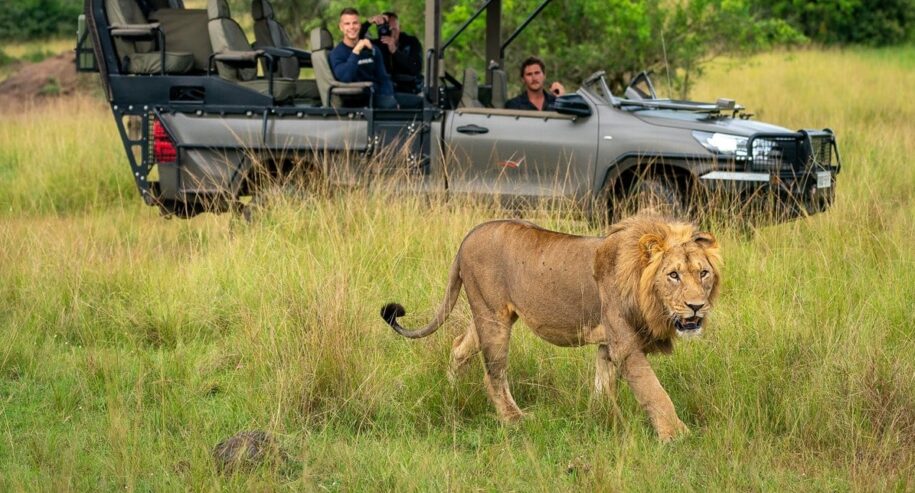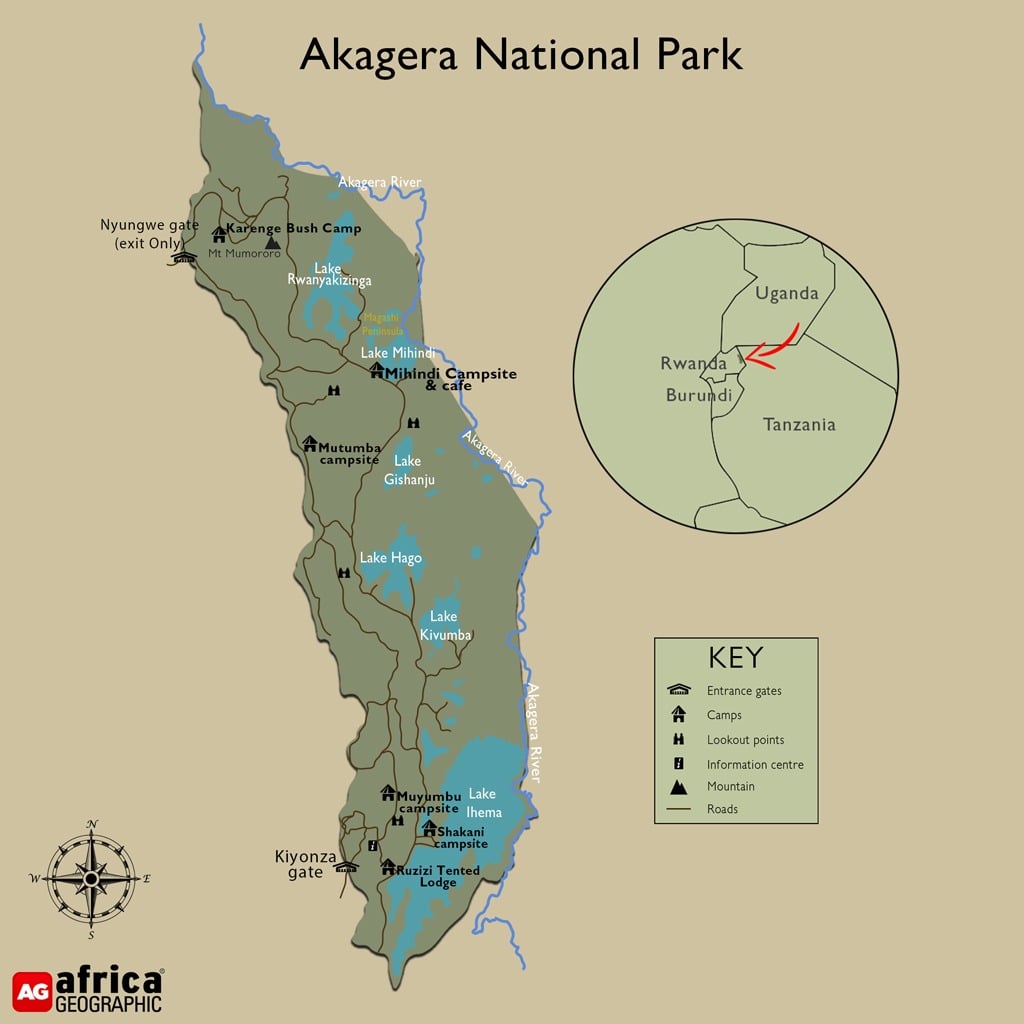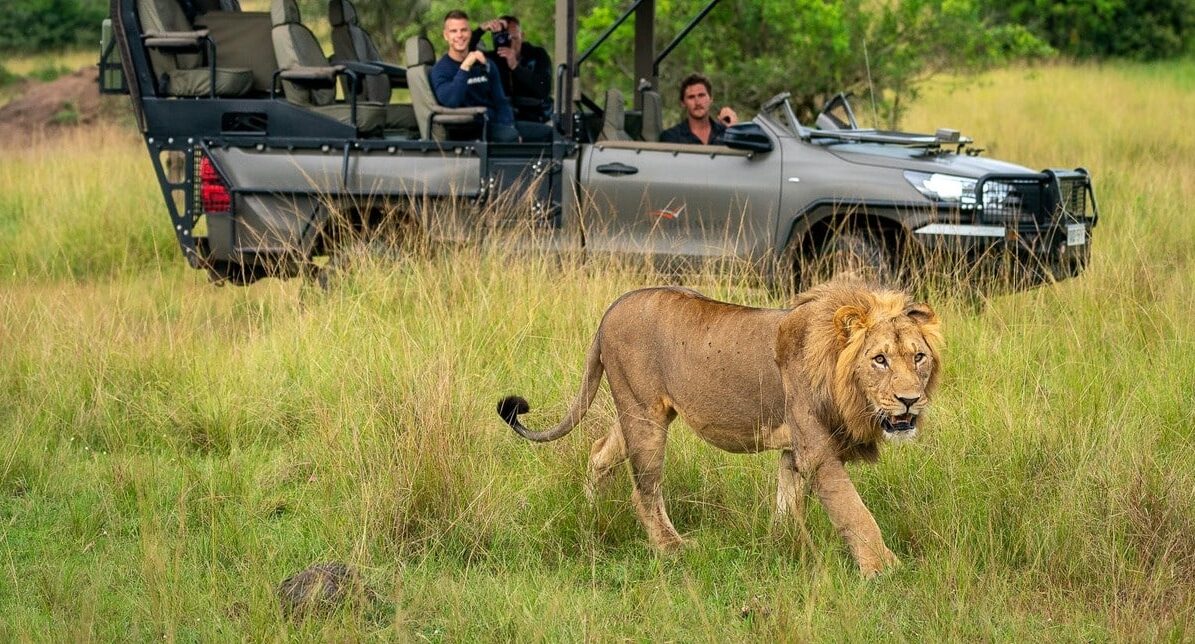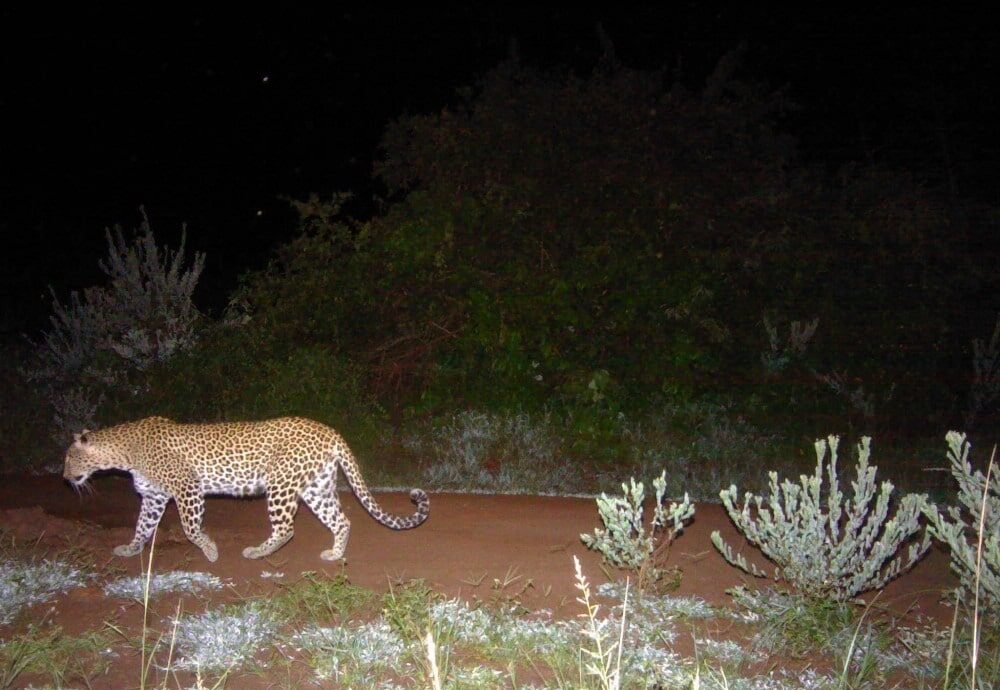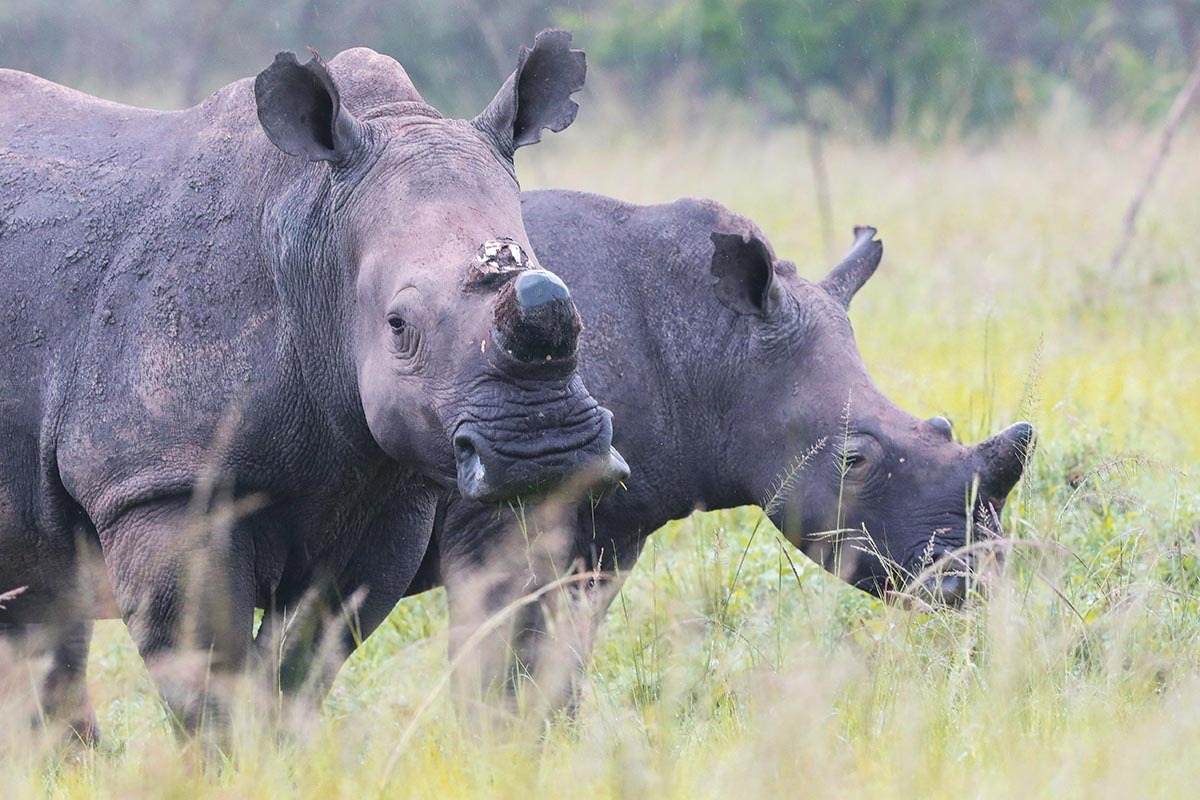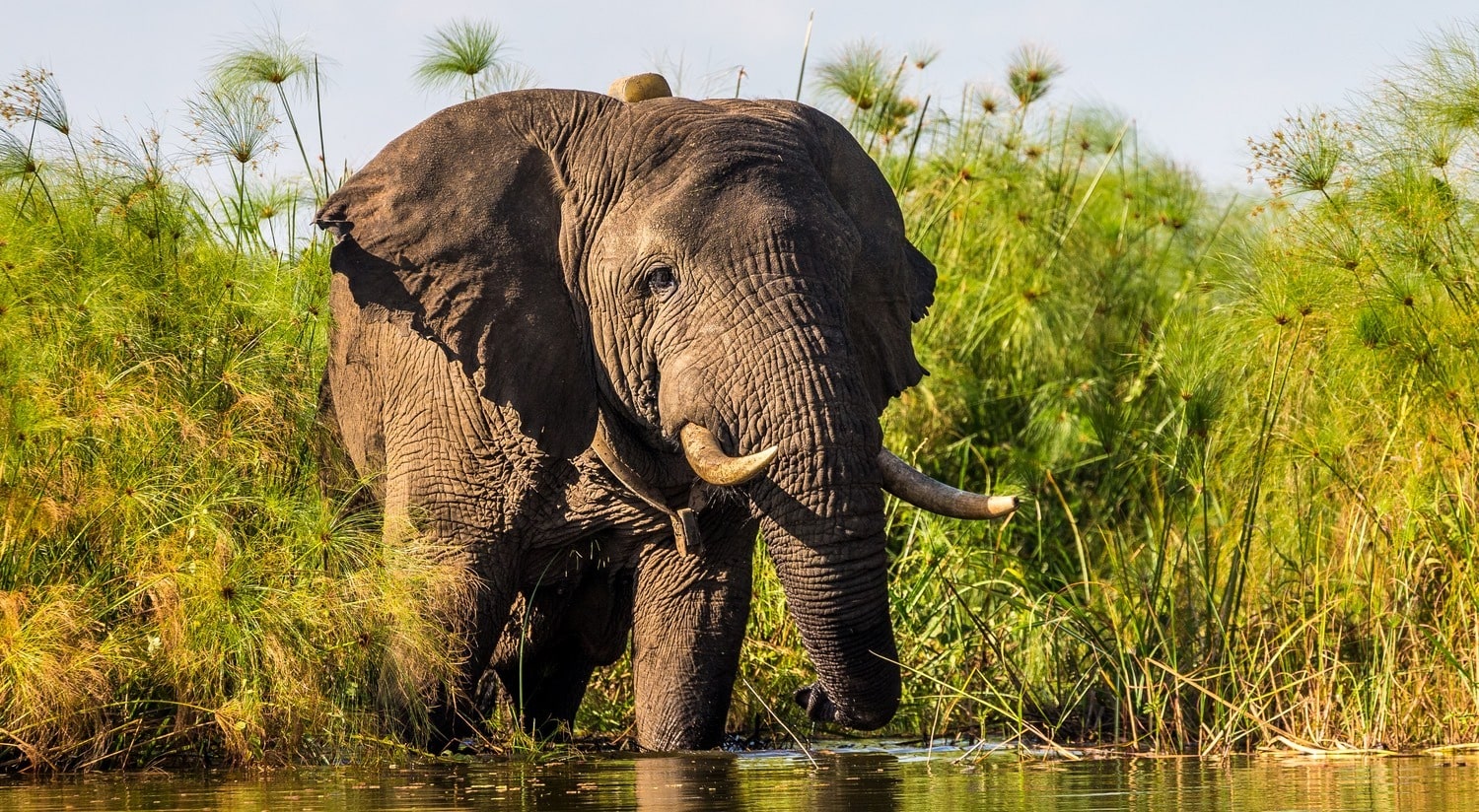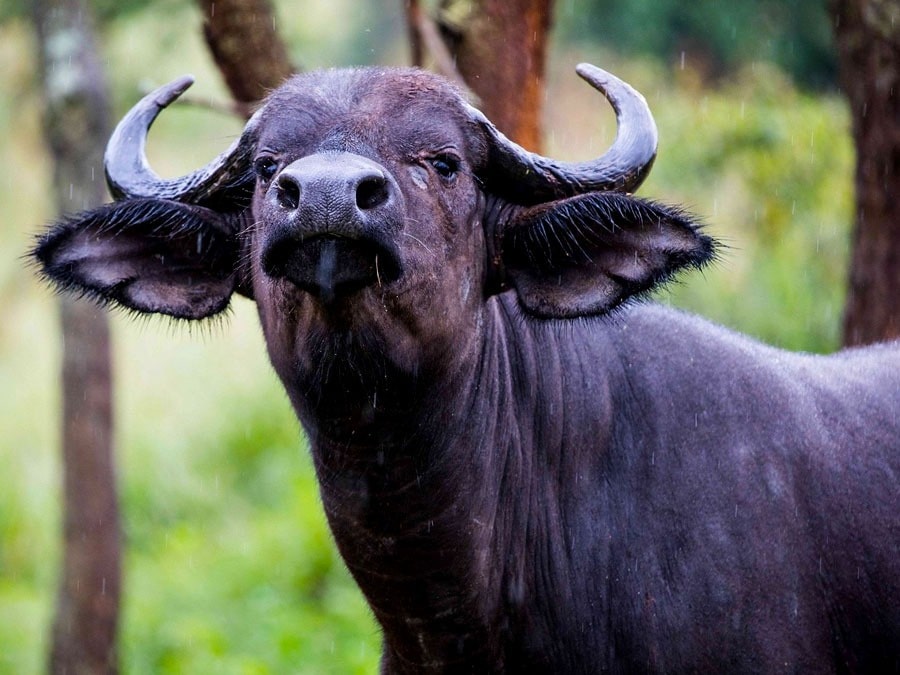Akagera National Park functions as Rwanda’s principal savannah wildlife destination.
Located in the country’s eastern lowlands, it marks the only park in Rwanda that supports all members of the Big Five: lion, leopard, elephant, rhino, and buffalo.
The park spans approximately 1,122 square kilometres and borders the Kagera River and Lake Ihema, creating a corridor of permanent water sources and floodplains that support year-round game viewing.
Since 2010, Akagera has undergone a measured conservation turnaround under the management of African Parks, working in partnership with the Rwanda Development Board.
Their reintroduction of lions in 2015 and black rhinos in 2017 marked a critical shift in the park’s status as a full-spectrum wildlife destination.
If you’re interested in understanding where Rwanda’s lowland safari economy fits within East African circuits, this is the place to begin.
Location and Accessibility
- Geographical Placement
Akagera lies in Rwanda’s Eastern Province, specifically within Kayonza and Nyagatare districts. The park extends along the border with Tanzania and is defined by an arc of interconnected lakes, swamps, and open plains adjacent to the Kagera River.
- Access from Kigali
From Kigali, the most direct route to the park covers approximately 110 kilometres. This drive typically takes 2.5 to 3 hours, depending on traffic conditions and weather. Most visitors travel through Rwamagana and continue via Kayonza before reaching the southern gate near Kabarondo.
- Park Entry Gates
The park operates two main access points. The southern gate, near the Akagera Park headquarters at Nyungwe Hill, serves as the primary entrance. The northern gate is an exit-only location, situated near the town of Mutumba. It allows circuit-style routing through the park for those on full-day game drives or through-drives.
- Transport Options
Visitors can self-drive using 4×4 vehicles, which remain essential for navigating internal game tracks. Several licensed operators offer guided safaris departing from Kigali. Additionally, Akagera Aviation offers helicopter transfers to nearby airstrips, reducing travel time to under 30 minutes for high-end itineraries. If you’re planning a same-day return or a multi-park circuit, consider coordinating your park entry timing with your accommodation check-in to avoid delays.
Brief History of Akagera National Park
Akagera National Park was gazetted in 1934 under the Belgian colonial administration.
At the time, it spanned over 2,500 square kilometres, protecting a complex of savannah, papyrus swamps, and riverine woodland ecosystems. The original boundaries extended north to encompass extensive seasonal wetlands and buffalo migration corridors along the Kagera River.
In the aftermath of the 1994 Genocide against the Tutsi, over 700,000 returning refugees required land for resettlement and agriculture.
As a result, approximately 50 percent of the park was degazetted in 1997. This loss of territory severely compromised wildlife populations, with key species disappearing under mounting human pressure and widespread poaching.
A formal co-management agreement signed in 2010 between the Rwanda Development Board and African Parks marked a decisive shift in Akagera’s trajectory.
That partnership introduced an intensive model of ecological restoration, infrastructure development, and ranger-led security.
Within five years, lions were reintroduced from South Africa, followed by black rhinos in 2017 and southern white rhinos in 2021.
Today, Akagera stands as one of the few fully fenced national parks in Africa, offering both ecological stability and improved human-wildlife coexistence.
READ ALSO: The Future of Gorilla Conservation in Rwanda – Challenges and Opportunities
The Big Five in Akagera National Park
1. Lions
Akagera lost its lions by the early 2000s. Poaching and ecosystem decline had led to a collapse in the population.
In 2015, a founding group of seven lions, comprising five females and two males, relocated to Rwanda through an initiative led by African Parks and the Rwanda Development Board.
Within months, they bred.
Today, the park is home to over 50 lions, with active territorial expansion occurring across the northern and central savannah.
You’re most likely to find them near Kilala Plain or along the Magashi sector. These lions hunt buffalo, zebra, and impala, and can be heard vocalizing across several kilometers in the early morning hours.
2. Leopards
Leopards exist in lower densities and are rarely seen during the day. They favour wooded escarpments and rocky slopes, often occupying areas near Nyungwe Hill and Mutumba.
Sightings have increased since the installation of camera traps and structured night drives. They move alone, mark territories with scent, and hunt bushbuck, monkeys, and smaller antelope.
Drivers familiar with leopard movements recommend scanning ridge edges during the early morning light. You may not spot one easily, but the park holds a stable breeding population.
3. Rhinos
Akagera is home to both black and white rhinos. In 2017, 18 eastern black rhinos were translocated from South Africa—the species had been missing from the park for over a decade.
Four years later, 30 southern white rhinos were flown in from the &Beyond Phinda Reserve, expanding the genetic and ecological range.
While black rhinos tend to keep to dense scrub, white rhinos often graze near open floodplains in the north. Rangers monitor all individuals using GPS tracking.
The sight of a white rhino standing knee-deep in morning mist, unmoved by your engine’s hum, is not something you forget quickly.
4. Elephants
Akagera’s elephant population descends from a group relocated in the 1970s.
Over time, they established breeding herds concentrated around the central sector. Current estimates suggest that more than 120 individuals, including mature bulls and calf clusters, are present.
Elephants frequent lake margins and mud wallows during dry periods. Some herds cross internal roads in the early afternoon, often pausing in clearings before re-entering cover.
Their ecological role encompasses seed dispersal, habitat modification, and the creation of water access. They’re not difficult to find. Their impact is visible even when they’re not.
5. Buffaloes
Cape buffaloes remain the park’s most numerous Big Five species. Large herds roam grasslands north of Lake Hago, often crossing open plains in single file.
Males sometimes detach from the group and form bachelor herds near water points. Buffaloes graze early, rest midday, and gather at water bodies late in the afternoon.
While they rarely flee from vehicles, they’re unpredictable when threatened. Their population helps sustain predator densities, especially lions.
Other Wildlife Highlights
Akagera National Park supports a high biomass of grazing and browsing herbivores. Masai giraffes, first introduced in 1986, have adapted well to the open woodland zones in the park’s north and central areas.
Population surveys in 2024 recorded over 100 individuals. Giraffes are frequently observed near acacia stands, feeding on upper canopies during early morning hours. Burchell’s zebras remain widely distributed and often graze alongside impalas and topis.
Eland, the largest antelope species, favours the transitional zones between swamp and dry grassland, while oribi and reedbuck occupy lower ground near wetland margins.
Among the park’s secondary predators, the spotted hyena has shown consistent population growth under the current management regime.
They operate in loosely structured clans and are commonly seen during night drives, particularly near salt licks and watering points.
Side-striped jackals, serval cats, and genets also contribute to nocturnal carnivore diversity, although they are less frequently recorded due to their shy and cryptic nature.
The lakes and swamps in Akagera National Park sustain large populations of Nile crocodiles and hippos.
Lake Ihema, in particular, serves as a habitat for dozens of hippo pods, with their vocalisations audible across much of the southern sector.
Crocodiles favor the lake’s exposed banks and smaller satellite water bodies, including Lake Shakani and Lake Hago, where fish populations remain stable throughout the year.
For birdlife, Akagera National Park ranks among the top destinations in East-Central Africa.
The park hosts more than 500 recorded species, including several range-restricted and papyrus-dependent birds. Notable species include the shoebill stork, papyrus gonolek, and African fish eagle. Seasonal migrants swell the counts between September and March, with Palearctic species frequenting the park’s northern and wetland zones.
Safari Activities and Experiences in Akagera National Park
Day Game Drives
Daytime game drives remain the primary method for wildlife viewing in Akagera National Park. Visitors can use their own 4×4 vehicles or hire a park guide for structured routing. Most drives begin at the southern gate and follow marked loops through Nyungwe Valley, Kilala Plain, and the central lake zones. Morning departures (06:00 to 10:00) offer the best visibility, while afternoon drives may yield more predator activity.
Night Drives
Night drives, conducted exclusively with park guides and vehicles, depart at 17:30 and last approximately two hours. These drives utilize red-filtered spotlights to minimize animal disturbance and enhance eye-shine detection. Common sightings include hyenas, bush babies, leopards, genets, and porcupines. If you’ve never tracked wildlife after dark in a structured setting, this is a methodical introduction to the study of octurnal ecology.
Boat Safaris on Lake Ihema
Boat safaris operate on a schedule from the southern jetty at Lake Ihema, with departures at 07:30, 09:00, 15:00, and 16:30. Each trip lasts about 1 hour and accommodates up to 11 guests. Passengers observe hippos, crocodiles, water birds, and elephants from a low, stable vantage point. The early morning departure is typically quieter, while the 16:30 session aligns with higher wildlife activity along the water’s edge.
Birding Excursions
Birding is available throughout the year, with the highest productivity during the wet seasons. Papyrus swamps support wetland specialists, such as the papyrus gonolek and lesser jacana. Savannah and acacia zones are home to helmeted guineafowl, crowned lapwings, and blue-naped mousebirds. Visitors can book birding-focused guides, who carry field scopes and coordinate routes based on seasonal data and bird migration patterns.
Fishing at Lake Shakani
Lake Shakani allows regulated fishing using personal or rented rods. Species include tilapia and catfish, though catch-and-release is recommended. Permits are available at park headquarters. Fishing here offers a rare opportunity to engage directly with Akagera’s aquatic systems, making it a good choice if you want to spend time away from vehicle-based activities.
Conservation Success and Community Involvement
Since 2010, Akagera National Park has been managed jointly by the Rwanda Development Board and African Parks.
This agreement introduced a results-based conservation framework with dedicated funding, trained ranger units, and a centralised monitoring system.
Over 100 rangers currently patrol the park, supported by aircraft surveillance, sniffer dogs, and real-time digital reporting. Recorded poaching incidents have dropped by more than 95 percent over the past decade.
At the same time, wildlife populations, including lions, rhinos, and giraffes, have increased steadily under structured reintroduction programmes.
The park’s ecological recovery has also benefited from investments in infrastructure. A 120-kilometre perimeter fence, completed in 2013, reduced human-wildlife conflict and stabilised internal grazing zones.
Wetland health along the Akagera River improved due to reduced cattle intrusion and regulated fishing. The IUCN now recognises Akagera as a functioning savannah ecosystem with natural predator-prey dynamics, seasonal migration corridors, and long-term ecological monitoring protocols.
Community engagement operates through a multi-tiered revenue-sharing scheme and direct employment.
Approximately 10 percent of park revenue is channelled into local development projects, including water access, school infrastructure, and cooperative farming. Over 300 staff work across park operations, hospitality, and conservation programmes, with priority given to residents of neighbouring sectors. Educational outreach encompasses youth eco-clubs, site visits, and conservation training, all of which are delivered in partnership with local district authorities.
When to Visit Akagera National Park
Akagera National Park experiences two dry seasons and two rainy seasons each year. The long dry season runs from June to September, while the shorter dry season occurs between December and early February.
These periods offer the best conditions for wildlife viewing. Vegetation thins, visibility improves, and animals concentrate near water bodies, particularly in the northern plains and along Lake Mihindi.
During the rains, from March to May and again in October and November, some tracks become slippery, and game disperses more widely. However, bird activity increases significantly during the wetter months, especially among water-associated species.
Visitor volume peaks between July and early October. Accommodation tends to fill quickly during this time, especially at Magashi and Ruzizi.
If you’re targeting quieter periods, consider late January or early June, when conditions remain dry but bookings ease. Photographers often prefer the early wet season for the diffused light and sharper contrasts.
Regardless of the season, gates open at 6:00 AM and close at 6:00 PM. Most guided activities must be pre-booked to align with staffing and park regulations.
Conclusion
Some parks leave you with memories. Others leave you with structure. Akagera National Park does both, but not in the way you might expect.
What stays with you is the quiet order of things, the deliberate way it all holds together. The patrol logs, the fence lines, the wildlife corridors, even the timing of the gates—nothing feels accidental. If you’re paying attention, you’ll see it: a protected space that is trying to last.

